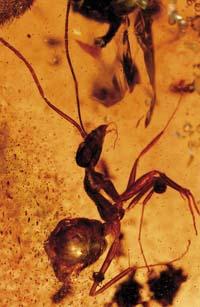India's ancient biodiversity in amber

In western India, within a 50-million-year-old amber, fossils of old 700 species of insects have been found, most of them in very good condition. The study was conducted by a team of researchers from the Bonn University of Germany. This discovery has allowed us to verify that the biodiversity of India did not develop in isolation, as previously thought.
The researchers have extracted more than 136 kilos of amber from the deposits. The origin of this fossilized resin is found in a family of tropical trees spread worldwide. Fossils of insects, arachnids and well-preserved crustaceans, belonging to more than 55 families, as well as plant and fungal remains have been found dissolved in amber.
The researcher has surprised his relationship with current Asian and Australian species. And they have seen that they are also related to other species that have been found in Mexico or Central America long ago. Thus, they conclude that 50 million years ago India and Asia were not completely separated. "India was isolated, but we are not clear when or how long. Amber of India has a primitive record of a multifauna tropical forest. We have obtained biological evidence that indicates a certain biotic relationship", explained the researchers.





